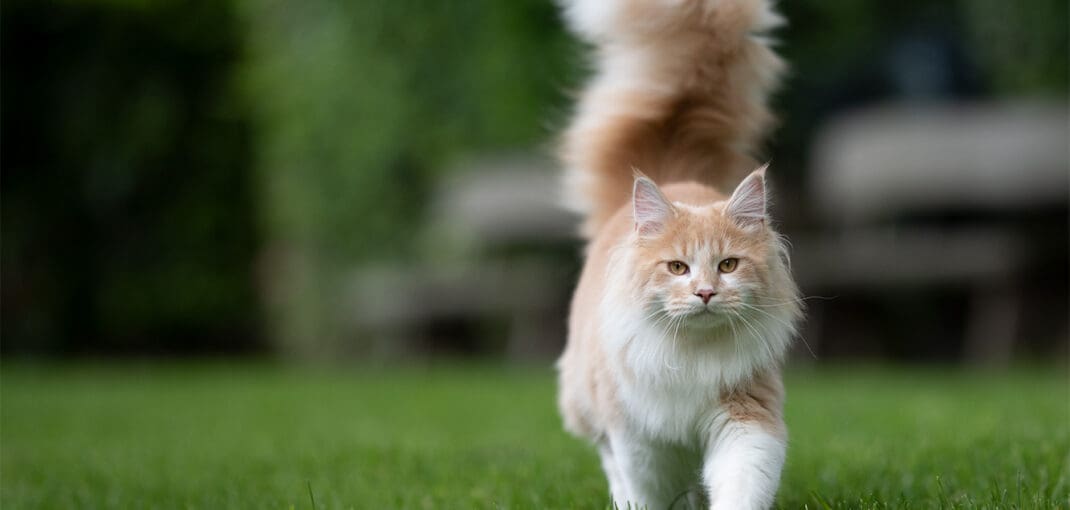One of the popular sayings, concerning cats, is the one about tail-wagging: a cat that wags its tail is supposed to be angry and it is better not to hook it. Is this actually the case? Not really. For it turns out that the world of cat communication is much more complex and requires us to be quite attentive – and not just when it comes to the tail.
Feline communication methods
In the feline world, we can observe different ways of communication that pets use depending on the situation and what they want to communicate. The main division is the one distinguishing three groups of messages:
auditory,
olfactory,
visual.
If we want to talk about the cat’s tail, we need to focus primarily on the last category, because the signals sent out using the tail belong precisely to the visually perceived messages. Of course, they can be combined with the other forms of communication (e.g. a cat with a fluffy tail may hiss, and a cat shaking its tail raised vertically may simultaneously mark the area with urine). The most important thing, however, is to remember that the cat is a whole and, when receiving its messages, we must not focus solely on the tail!
How do you ‘read’ a cat? What does a cat’s tail tell us?
Before paying attention to the movements or positioning of the tail, it is worth taking a look at the whole animal: its posture, any tension or relaxation of the body, the expression of the eyes, the positioning of the ears and whiskers, the positioning of the coat. Also pay attention to gestures, such as nose licking or looking away or, on the contrary, gazing intensely at an object or point, willingness or unwillingness to make eye contact and physical contact. The whole situational context surrounding the cat’s behaviour is important. When we have all this analysed, we are free to look at the tail as well. For if we look only at the tail, we will achieve an effect similar to trying to watch a film through a keyhole – we will undoubtedly see something, but the picture will not be complete.
Tail signals
Cats usually use their tail to send a message at a distance or to convey ongoing emotions through it. Some interesting examples can be given here:
tail stretched upwards or slightly curved at the end ‘in a question mark’ – this is how tails are usually worn by animals that are confident, happy or those that want to say hello. This is a very interesting signal, transferred from intra-species communication to human contact. In the wild, kittens wag their tails when they hear their mother calling, making it easier for the female cat to track the little ones in tall grass or scrub. As a result of the domestication process, cats have transferred this communication to contact with us, which may suggest that they treat us somewhat like parents;
a tail glued to the body or tucked under the belly – this in turn is often a signal of fear, anxiety or uncertainty. It may also be accompanied by bending of the paws and general limping, because the animal wants to appear as small as possible at the same time (according to the principle ‘since I am small, it is not worth being interested in me, because I am not a threat to anyone’).
Such a message usually means that the animal needs help because it is unwell in a situation;
a tail curled against the wrists of the front paws in a sitting cat – this position says ‘I’m watching, but I don’t want to be touched, so keep your distance’. This is not yet a deterrent message, but it is a clear signal that the pet has no desire for proximity;
rubbing its tail against a human or another animal – this is a very friendly signal expressing a desire for closeness and a high degree of trust. Cats in the wild do not stroke each other, but they may embrace each other with their tails, e.g. when walking together in the same direction. This is an expression of great intimacy and should always be appreciated;
a fluffy coat on the tail or a tail curved into an inverted U is often an expression of nervousness or anxiety related to the fact that the animal is afraid of something (e.g. a loud sound). Piloerection, i.e. a ruff of fur on the tail, back or the whole body, is intended to optically increase the size of the individual, thus showing that it will not be an easy opponent and it is better not to mess with it. It also happens that cats, especially young ones, wag their tail when playing. If this happens it is usually evidence of a great deal of excitement rather than fear,
gentle ‘knocking’ with the tip of the tail – this is a signal of irritation and a sign that our cat is running out of patience. Therefore, if such behaviour appears when we stroke our pet, we should immediately stop this activity;
strong thumping with the tail up to the so-called ‘beating against the sides’. – is usually an indicator of frustration or strong nervousness. Such a message should be perceived as a message that reads: ‘I’ve had enough, go away immediately!’. Sometimes such reactions are also observed when the cat cannot fulfil some need (e.g. to hunt a bird sitting outside the window). It is then worth redirecting its attention to another object or activity to relieve the tension;
tail half lowered, hanging freely behind cat when moving, indicates general relaxation and ease. Such a tail conveys nothing more to us than that the animal is feeling well and nothing is bothering it.
What else is worth knowing?
The tail is responsible for the sense of balance in cats – its work is used to maintain balance in the body, which is very helpful during running, sudden turns and also jumping, especially over longer distances. Therefore, any injury to the tail can cause the cat to have balance problems and, for example, make certain places in the house unreachable for it.
Unfortunately, the cat’s tail is quite susceptible to injury, so never tug on the cat’s tail or pull it by this part of the body, e.g. from a hiding place. If the cat were to fall on the base of the tail, the tail could be fractured or the vertebrae could be damaged, so a follow-up X-ray should always be taken to check for serious injury.
In long-haired and semi-long-haired cats it is also important not to over-groom the tail, as the hair on it grows the slowest. Therefore, it is advisable to comb it much less frequently than the rest of the coat in order not to lead to hair loss.






